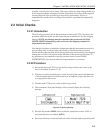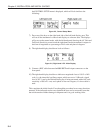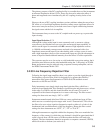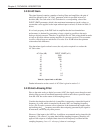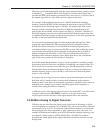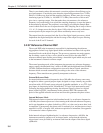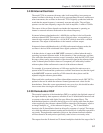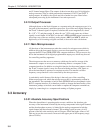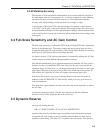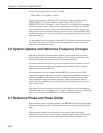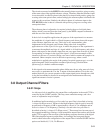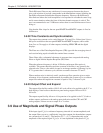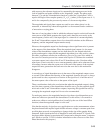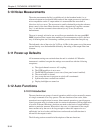
3-7
Chapter 3, TECHNICAL DESCRIPTION
3.2.08 Internal Oscillator
The model 7220, in common with many other lock-in amplifiers, incorporates an
internal oscillator which may be used to drive an experiment. However, unlike most
other instruments, the oscillator in the model 7220 is digitally synthesized with the
result that the output frequency is extremely accurate and stable. The oscillator
operates over the same frequency range as the lock-in amplifier, 1 mHz to 120 kHz.
The source of the oscillator depends on whether the instrument is operating on
internal or external reference mode and on the selected frequency.
In internal reference baseband mode (< 60 kHz) the oscillator is derived from the
reference channel DSP. This outputs a series of digital values, corresponding to a
sinusoid at the required frequency, to a 16-bit DAC which in turn feeds a variable
attenuator. The output of the attenuator is the internal oscillator output.
In internal reference highband mode (> 60 kHz) and external reference mode, the
oscillator is derived from a dedicated direct digital synthesizer (DDS).
A further choice of output at the OSC OUT connector is offered when the unit is
operating in external reference mode. In this situation, if the synchronous oscillator
(also called the demodulator monitor) control is turned on, then the OSC OUT signal
becomes a direct analog representation of the sinusoidal signal at the reference input
to the X channel phase sensitive detector. Consequently it is affected by both the
reference phase shifter and harmonic controls of the reference channel.
For example, if an external reference at 1 kHz were applied, the unit were set to
operate in the 2F mode and the synchronous oscillator were turned on, then the signal
at the OSC OUT connector would be a 2 kHz sinusoid whose phase could be
adjusted using the reference phase shifter.
When used in the synchronous oscillator (demodulator monitor) mode, OSC OUT is
updated at the rate at which the reference channel generates new values for the
demodulators. Since this occurs approximately once every 6 µs, this should be taken
into account when viewing the waveform on an oscilloscope.
3.2.09 Demodulator DSP
The essential operation of the demodulator DSP is to multiply the digitized output of
the signal channel by data sequences called the X and Y demodulation functions and
to operate on the results with digital low-pass filters (the output filters). The
demodulation functions, which are derived by use of a look-up table from the phase
values supplied by the reference channel DSP, are sinusoids with frequency equal to
an integer multiple, nf
ref,
of the reference frequency f
ref.
The Y demodulation
function is the X demodulation function delayed by a quarter of a period. The integer
n is called the reference harmonic number and in normal lock-in amplifier operation is
set to unity. Throughout the remainder of this text, the reference harmonic number
will be assumed to be unity unless specifically stated to have a non-unity value.
The outputs from the X channel and Y channel multipliers feed the first stage of the X



